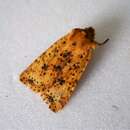en
names in breadcrumbs


Gwyfyn sy'n perthyn i urdd y Lepidoptera yw gwinau mannog, sy'n enw gwrywaidd; yr enw lluosog ydy gwyfynod gwinau mannog; yr enw Saesneg yw Dotted Chestnut, a'r enw gwyddonol yw Conistra rubiginea.[1][2]
Mae i'w ganfod drwy Ewrop. Hyd adenydd yr oedolyn ydy rhwng 30–35 mm ac mae i'w ganfod yn hedfan rhwng Hydref a Thachwedd, gan ddibynu ar ei leoliad.
Gellir dosbarthu'r pryfaid (neu'r Insecta) sy'n perthyn i'r Urdd a elwir yn Lepidoptera yn ddwy ran: y gloynnod byw a'r gwyfynod. Mae'r dosbarthiad hwn yn cynnyws mwy na 180,000 o rywogaethau mewn tua 128 o deuluoedd.
Wedi deor o'i ŵy mae'r gwinau mannog yn lindysyn sy'n bwyta llawer o ddail, ac wedyn mae'n troi i fod yn chwiler. Daw allan o'r chwiler ar ôl rhai wythnosau. Mae pedwar cyfnod yng nghylchred bywyd glöynnod byw a gwyfynod: ŵy, lindysyn, chwiler ac oedolyn.
Gwyfyn sy'n perthyn i urdd y Lepidoptera yw gwinau mannog, sy'n enw gwrywaidd; yr enw lluosog ydy gwyfynod gwinau mannog; yr enw Saesneg yw Dotted Chestnut, a'r enw gwyddonol yw Conistra rubiginea.
Mae i'w ganfod drwy Ewrop. Hyd adenydd yr oedolyn ydy rhwng 30–35 mm ac mae i'w ganfod yn hedfan rhwng Hydref a Thachwedd, gan ddibynu ar ei leoliad.
Conistra rubiginea, the dotted chestnut, is a moth of the family Noctuidae. The species was first described by Michael Denis and Ignaz Schiffermüller in 1775. It is distributed in Europe and, according to William Warren, Armenia and Asia Minor.
C. rubiginea F. ( pulverea Hbn., neurodes Hbn., rubigo Rmb.) (36 e). Forewing fulvous yellow; the lines fulvous brown, marked by black spots on veins; the basal, inner, and outer lines double; median shade often broad and diffuse, rarely swollen so as to darken the central area on inner margin; orbicular and reniform of the pale ground colour, undefined, the former with a black centre, the latter with lower lobe black, the lateral margin on each side of it pale yellow; terminal area narrowly brown; hindwing blackish fuscous, the fringe rufous; —. specimens suffused with fulvous brown form the ab. tigerina Esp. (36 e);— unicolor Tutt has body and forewing brick-red, the black points few, restricted to base of submedian fold, the centre of orbicular stigma, the submarginal and marginal points, and the lower part of the reniform; hindwing reddish ochreous with dark brown suffusion; — ab. modesta Hmps. has the thorax and forewing deep fulvous, except the basal area and the lines of the stigmata, which remain yellow; — ab. completa Hmps. (36 e) has the thorax and forewing uniformly deep fulvous. Larva dark brown, with a black blotch on each segment on the dorsum; lines obscurely paler; a dark line above the feet; feeds on numerous low plants. The larva, which is anomalously protected by brownish-yellow hairs, is said to be found, as well as the pupa, in ants' nests. [1] The wingspan is 30–35 mm.
.
The moth flies from October to November depending on the location.
The larvae feed on various deciduous trees including Quercus, Salix and Ulmus, it has also been observed herbaceous plants including Plantago.
Conistra rubiginea, the dotted chestnut, is a moth of the family Noctuidae. The species was first described by Michael Denis and Ignaz Schiffermüller in 1775. It is distributed in Europe and, according to William Warren, Armenia and Asia Minor.
De gevlekte winteruil (Conistra rubiginea) is een nachtvlinder uit de familie van de uilen, de Noctuidae.
De voorvleugellengte bedraagt tussen de 15 en 17 millimeter. De grondkleur van de voorvleugels is oranjerood tot bruingeel met een grote hoeveelheid donkere vlekken, dat zorgt voor een bonte verschijning.
De gevlekte winteruil gebruikt diverse loofbomen als waardplanten, waaronder appel, pruim, sleedoorn en wilg. De rups is te vinden van april tot juni. De soort overwintert als imago.
De soort komt verspreid over het Europa en van Klein-Azië tot de Kaukasus voor.
De gevlekte winteruil is in Nederland een niet zo gewone en in België een zeldzame soort. De vlinder kent één generatie die vliegt van halverwege september tot halverwege november, en na overwintering van februari tot en met april.
De gevlekte winteruil (Conistra rubiginea) is een nachtvlinder uit de familie van de uilen, de Noctuidae.
Gult flatfly (Conistra rubiginea) er en sommerfugl som tilhører familien nattfly (Noctuidae). Den er ganske sjelden i Norge og er funnet mest på den sørligste delen av Østlandet.
Et middelsstort (vingespenn 33 – 37 mm), tettbygd nattfly med litt flat kropp. Arten er lett å kjenne igjen på forvingenes mønster. Forvingen er okergul til oransjebrun, noe blekere etter overvintring, overstrødd med svarte flekker. Bakvingen er grå med rødlige eller gule frynser. Larven er sparsomt kledt med ganske lange, lyse hår.
Gult flatfly lever i løvskog, særlig med innslag av eik. Larvene lever først på knopper av ulike busker og løvtrær, senere på urter. De voksne sommerfuglene flyr om natten i september – oktober, før de overvintrer og flyr igjen i mars – mai.
Gult faltfly finnes bare i Europa, østover til Ural. I Norge er den sjelden og er funnet fra Østfold til Åmli og Arendal i Aust-Agder.
Gult flatfly (Conistra rubiginea) er en sommerfugl som tilhører familien nattfly (Noctuidae). Den er ganske sjelden i Norge og er funnet mest på den sørligste delen av Østlandet.
Conistra rubiginea é uma espécie de insetos lepidópteros, mais especificamente de traças, pertencente à família Noctuidae.[1]
A autoridade científica da espécie é Denis & Schiffermüller, tendo sido descrita no ano de 1775.
Trata-se de uma espécie presente no território português.
Conistra rubiginea é uma espécie de insetos lepidópteros, mais especificamente de traças, pertencente à família Noctuidae.
A autoridade científica da espécie é Denis & Schiffermüller, tendo sido descrita no ano de 1775.
Trata-se de uma espécie presente no território português.
Conistra rubiginea là một loài bướm đêm trong họ Noctuidae.[1][2]